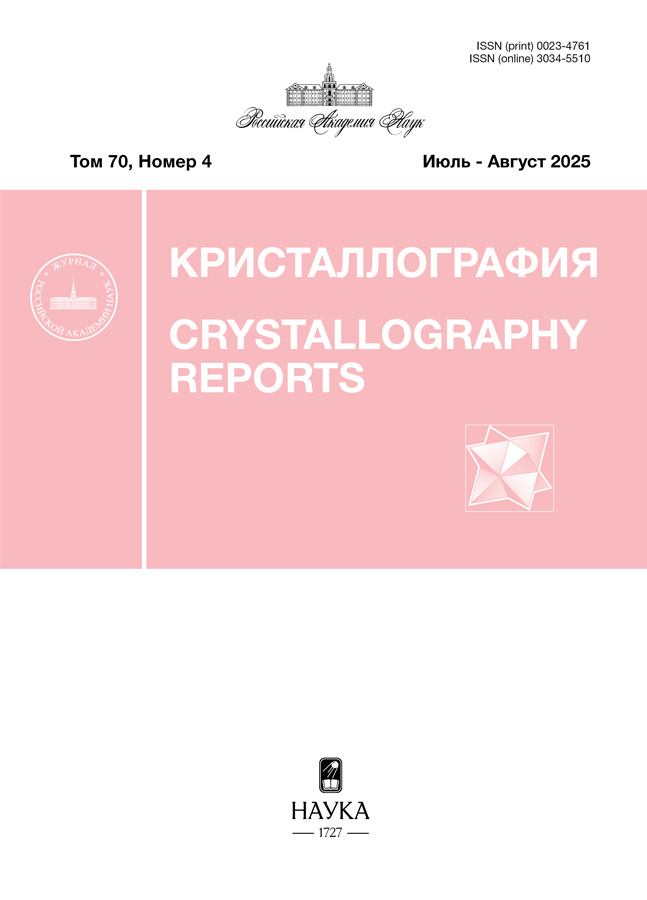X-ray diffraction tomography: image filtering by singular value decomposition and 1D smoothing Whittaker-Eilers methods
- Authors: Chukhovskii F.N.1, Konarev P.V.1, Volkov V.V.1
-
Affiliations:
- National Research Center “Kurchatov Institute”
- Issue: Vol 70, No 4 (2025)
- Pages: 545–551
- Section: ДИФРАКЦИЯ И РАССЕЯНИЕ ИОНИЗИРУЮЩИХ ИЗЛУЧЕНИЙ
- URL: https://consilium.orscience.ru/0023-4761/article/view/688065
- DOI: https://doi.org/10.31857/S0023476125040016
- EDN: https://elibrary.ru/JEVJOA
- ID: 688065
Cite item
Abstract
Digital processing of the 2D noisy X-ray diffraction images (2D-XDI) of a single point defect in Si(111) crystal, registered at the level of dispersion of statistical Gaussian noise of the detector using filtering methods such as singular value decomposition and 1D-line-by-line smoothing of test 2D-XDIs, is carried out. The efficiency of digital filtering of 2D-XDI is evaluated and analyzed by means of control parameter FOM (figure-of-merit) value of reconstruction of the displacement field function of a point defect of Coulomb type fh(r–r0), (h – diffraction vector, r0 – radius-vector of the defect position in the sample). It is shown that the filtering technique using the singular value decomposition of 2D-XDI works significantly better than the 1D linear-by-line smoothing method of 2D-XDI, which, apparently, in relation to our problem requires further research on its improvement.
Full Text
About the authors
F. N. Chukhovskii
National Research Center “Kurchatov Institute”
Author for correspondence.
Email: f_chukhov@yahoo.ca
Shubnikov Institute of Crystallography of the Kurchatov Complex Crystallography and Photonics
Russian Federation, MoscowP. V. Konarev
National Research Center “Kurchatov Institute”
Email: f_chukhov@yahoo.ca
Shubnikov Institute of Crystallography of the Kurchatov Complex Crystallography and Photonics
Russian Federation, MoscowV. V. Volkov
National Research Center “Kurchatov Institute”
Email: f_chukhov@yahoo.ca
Shubnikov Institute of Crystallography of the Kurchatov Complex Crystallography and Photonics
Russian Federation, MoscowReferences
- Chapman H.N. // Ultramicroscopy. 1996. V. 66. P. 153. https://doi.org/10.1016/S0304-3991(96)00084-8
- Rodenburg J.M., Hurst A.C., Cullis A.G. et al. // Phys. Rev. Lett. 2007. V. 98. P. 034801. https://doi.org/10.1103/PhysRevLett.98.034801
- Chapman H.N., Nugent K.A. // Nature Photonics. 2010. V. 4. P. 833. https://doi.org/10.1038/nphoton.2010.240
- Chapman H.N. // Nature. 2010. V. 467. P. 409. https://doi.org/10.1038/467409a
- Danilewsky A.N., Wittge J., Croell A. et al. // J. Cryst. Growth. 2011. V. 318. P. 1157. https://doi.org/10.1016/j.jcrysgro.2010.10.199
- Hänschke D., Danilewsky A., Helfen L. et al. // Phys. Rev. Lett. 2017. V. 119. P. 215504. https://doi.org/10.1103/PhysRevLett.119.215504
- Asadchikov V., Buzmakov A., Chukhovskii F. et al. // J. Appl. Cryst. 2018. V. 51. P. 1616. https://doi.org/10.1107/S160057671801419X
- Chukhovskii F.N., Konarev P.V., Volkov V.V. // Acta Cryst. A. 2020. V. 76. P. 163. https://doi.org/10.1107/S2053273320000145
- Chukhovskii F.N., Konarev P.V., Volkov V.V. // Crystals. 2023. V. 13. P. 561. https://doi.org/10.3390/cryst13040561
- Chukhovskii F.N., Konarev P.V., Volkov V.V. // Crystals. 2024. V. 14. P. 29. https://doi.org/10.3390/cryst14010029
- Чуховский Ф.Н., Волков В.В., Конарев П.В. Способ сбора и обработки данных рентгеновской дифракционной микротомографии. Патент. RU 2 824 297 C1 Рос. Фед. № 2008121372/04.
- Hendriksen A.A., Bührer M., Leone L. et al. // Sci. Rep. 2021. V. 11. P. 11895. https://doi.org/10.1038/s41598-021-91084-8
- Hamming R.W. Numerical Methods for Scientists and Engineers. New York: McGraw-Hill, 1961. 721 p.
- Бондаренко В.И., Рехвиашвили C.Ш., Чуховский Ф.Н. // Кристаллография. 2024. Т. 69. С. 755. https://doi.org/10.31857/S0023476124050012
- Eilers P.H.C. // Anal. Chem. 2003. V. 75. P. 3631. https://doi.org/10.1021/ac034173t
- Jha S.K., Yadava R.D.S. // IEEE Sensors J. 2011. V. 11. P. 35. https://doi.org/10.1109/JSEN.2010.2049351
- Golub G.H., Van Loan C.F. Matrix Computations. 4th Ed. Baltimore: Johns Hopkins Univ. Press, 2013. 756 p. Ch. 2.
- Yang W., Hong J.-Y., Kim J.-Y. et al. // Sensors. 2020. V. 20. P. 3063. https://doi.org/10.3390/s20113063
- Durbin J., Watson G.S. // Biometrika. 1971. V. 58. P. 1. https://doi.org/10.2307/2334313
- Деянов Р.З., Щедрин Б.М., Бурова Е.М. // Вычислительные методы и программирование. Вып. 39. М.: Изд-во МГУ, 1983. С. 55.
Supplementary files













